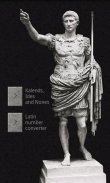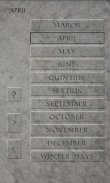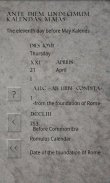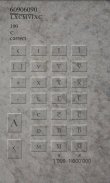






Kalends, Ides and Nones

Beschreibung von Kalends, Ides and Nones
The ancient Romans called the days of the month, referring to the Kalends, Ides and Nones, and that is what this application does: by entering a date, shows his wording in Latin (one of several). For ancient dates it shows some information about the organizing of the pertinent calendar. The application considers the Gregorian and Julian calendars and a reconstruction of Numa and Romulus (or Roman) calendars.
There is also a converter that uses the latin numbers subtractive principle (4 = IV) and, for numbers beyond 3999, the convention: a line above = per one thousand, two lines above = per one million. They can be inserted Arabic or Latin digits.</div> <div jsname="WJz9Hc" style="display:none">Die alten Römer nannten die Tage des Monats, die sich auf die Kalends, Ides und Nones, und das ist, was diese Anwendung funktioniert: durch Eingabe eines Datums, zeigt seine Formulierung in Latein (eine von mehreren). Für alte Daten zeigt einige Informationen über die Organisation des betreffenden Kalender. Die Anwendung ist der Auffassung, die Gregorianik und Julian Kalender und eine Rekonstruktion des Numa und Romulus (oder Roman) Kalender.
Es gibt auch einen Konverter, der das lateinische Zahlen subtraktiven Prinzip nutzt (4 = IV) und, für die Zahlen über 3999, die Konvention: eine Linie oben = pro Tausend, zwei Linien über = eine Million. Sie können arabische oder lateinische Zeichen eingefügt werden.</div> <div class="show-more-end">
























